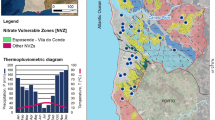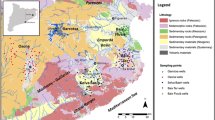Abstract
In recent years, high concentrations of hexavalent chromium, Cr(VI), have been observed in the groundwater system of the Asopos River Basin, raising public concern regarding the quality of drinking and irrigation water. The work described herein focuses on the development of a groundwater flow and Cr(VI) transport model using hydrologic, geologic, and water quality data collected from various sources. An important dataset for this goal comprised an extensive time series of Cr(VI) concentrations at various locations that provided an indication of areas of high concentration and also served as model calibration locations. Two main sources of Cr(VI) contamination were considered in the area: anthropogenic contamination originating from Cr-rich industrial wastes buried or injected into the aquifer and geogenic contamination from the leaching process of ophiolitic rocks. The aquifer’s response under climatic change scenario A2 was also investigated for the next two decades. Under this scenario, it is expected that rainfall, and thus infiltration, will decrease by 7.7 % during the winter and 15 % during the summer periods. The results for two sub-scenarios (linear and variable precipitation reduction) that were implemented based on A2 show that the impact on the study aquifer is moderate, resulting in a mean level decrease less than 1 m in both cases. The drier climatic conditions resulted in higher Cr(VI) concentrations, especially around the industrial areas.









Similar content being viewed by others
References
Aivalioti MV, Karatzas GP (2006) Modeling the flow and leachate transport in the vadose and saturated zone—a field application. Environ Model Assess 11(1):81–87
Andrews CB, Neville CJ (2003) Ground water flow in a desert basin: challenges of simulating transport of dissolved chromium. Groundwater 41(2):219–226
Babu DK, Pinder GF, Niemi A, Ahlfeld DP, Stothoff SA (1997) Chemical transport by three-dimensional groundwater flows. Princeton University USA84-WR-3.
Bakis R, Tuncan A (2011) An investigation of heavy metal and migration through groundwater from the landfill area of Eskisehir in Turkey. Environ Monit Assess 176:87–98
Becquer T, Quantin C, Sicot M, Boudot JP (2003) Chromium availability in ultramafic soils from New Caledonia. Sci Total Environ 301:251–261
Botsou F, Karageorgis AP, Dassenakis E, Scoullos M (2011) Assessment of heavy metal contamination and mineral magnetic characterization of the Asopos River sediments (Central Greece). Mar Pollut Bull 62:547–563
Cooper GRC (2002) Oxidation and toxicity of chromium in ultramafic soils in Zimbabwe. Appl Geochem 17:981–986
Daskalaki P, Voudouris ΖK (2008) Groundwater quality of porous aquifers in Greece: a synoptic review. Environ Geol 54:505–513
Delpla I, Jung A-V, Baures E, Clement M, Thomas O (2009) Impacts of climate change on surface water quality in relation to drinking water production. Environ Int 35:1225–1233
Dhakate R, Singh VS, Hodlur GK (2008) Impact assessment of chromite mining on groundwater through simulation modeling study in Sukinda chromite mining area, Orissa, India. J Hazard Mater 160:535–547
Dimitroula H, Syranidou E, Manousaki E, Nikolaidis NP, Karatzas GP, Kalogerakis N (2015) Mitigation measures for chromium-VI contaminated groundwater—the role of endophytic bacteria in rhizofiltration. J Hazard Mater 281:114–120
Dokou Z, Pinder GF (2011) Extension and field application of an integrated DNAPL source identification algorithm that utilizes stochastic modeling and a Kalman filter. J Hydrol 398(3-4):277–291
Dokou Z, Karatzas GP, Nikolaidis NP, Kalogerakis N (2013) Mapping of chromium in the greater area of Asopos river basin. 13th International Conference on Environmental Science and Technology (CEST), Athens
Domenico PA, Schwartz FW (1990) Physical and chemical hydrogeology. John Wiley & Sons, New York, p 824
Dragoni W, Sukhija BS (2008) Climate change and groundwater: a short review. Geological Society, 288th edn. Special Publications, London, pp 1–12
Economou-Eliopoulos M, Megremi I, Vasilatos C (2011) Factors controlling the heterogeneous distribution of Cr(VI) in soil, plants and groundwater: evidence from the Assopos basin, Greece. Chem Erde-Geochem 71:39–52
Economou-Eliopoulos M, Antivachi D, Vasilatos C, Megremi I (2012) Evaluation of the Cr(VI) and other toxic element contamination and their potential sources: the case of the Thiva basin (Greece). Geosci Frontiers 3(4):523–539
Economou-Eliopoulos M, Megremi I, Atsarou C, Theodoratou C, Vasilatos C (2013) Spatial evolution of the chromium contamination in soils from the Assopos to Thiva Basin and C. Evia (Greece) and potential source(s): anthropogenic versus natural processes. Geosciences 3:140–158
Fantoni D, Brozzo G, Canepa M, Cipolli F, Marini L, Ottonello G, Zuccolini MV (2002) Natural in groundwaters interacting with ophiolitic rocks. Environ Geol 42:871–882
Giannakopoulos C, Kostopoulou E, Varotsos KV, Tziotziou K, Plitharas A (2011) An integrated assessment of climate change impacts for Greece in the near future. Reg Environ Change 11:829–843
Fruchter J (2002) In situ treatment of chromium-contaminated groundwater. Environ Sci Technol 36:464–472
Heath RC (1983) Basic ground-water hydrology: U.S. Geological Survey. Water-Supply Paper 2220 86.
Hellerich LA, Nikolaidis NP (2005) Sorption studies of mixed chromium and chlorinated ethenes at the field and laboratory scales. J Environ Manage 75:77–88
IPCC (2014) Climate Change 2014 Impacts, Adaptation, and Vulnerability Part A: Global and Sectoral Aspects. In: Field CB (ed) Working group II contribution to the fifth assessment report of the intergovernmental panel on climate change V. R. B. Cambridge University Press, New York
Jacobs JA, Testa MS (2005) Overview of chromium (VI) in the environment: background and history. Chromium Handbook.
Kaprara E, Kazakis N, Simeonidis K, Coles S, Zouboulis AI, Samaras P, Mitrakas M (2015) Occurrence of Cr(VI) in drinking water of Greece and relation to the geological background. J Hazard Mater 281:2–11
Karatzas GP, Dokou Z (2015) Optimal management of saltwater intrusion in the coastal aquifer of Malia, Crete (Greece), using particle swarm optimization. Hydrogeol J 23(6):1181–1194
Karavoltsos S, Sakellari A, Mihopoulos N, Dassenakis M, Scoullos MJ (2008) Evaluation of the quality of drinking water in regions of Greece. Desalination 224(1):317–329
Lilli MA, Nikolaidis NP, Karatzas GP, Kalogerakis N, Mueller M (2013) Mitigation measures for hexavalent chromium contaminated groundwater and soil using zero valent iron technologies. 13th International Conference on Environmental Science and Technology (CEST), Athens
Mimikou M, Baltas E, Varanou E, Pantazis K (2000) Regional impacts of climate change on water resources quantity and quality indicators. J Hydrol 234:95–109
Moraetis D, Nikolaidis NP, Karatzas GP, Dokou Z, Kalogerakis N, Winkel LHE, Palaiogianni-Bellou A (2012) Origin and mobility of hexavalent chromium in North-Eastern Attica, Greece. Appl Geochem 27:1170–1178
Morrison JM, Goldhaber MB, Lee L, Holloway JM, Wanty RB, Wolf RE, Ranville JF (2009) A regional-scale study of chromium and nickel in soils of northern California, USA. Appl Geochem 24:1500–1511
Mystrioti C, Sparis D, Papasiopi N, Xenidis A, Dermatas D, Chrysochoou M (2015) Assessment of polyphenol coated nano zero valent iron for hexavalent chromium removal from contaminated waters. Bull Environ Contam Toxicol 94:302–307
Nikolaidis NP, Shen H (2000) Conceptual site model for evaluating contaminant mobility and pump and treat remediation. Global Nest 2(1):67–76
Novak M, Chrastny V, Cadkova E, Farkas J, Bullen TD, Tylcer J, Szurmanova Z, Cron M, Prechova E, Curik J, Stepanova M, Pasava J, Erbanova L, Houskova M, Puncochar K, Hellerich LA (2014) Common occurrence of a positive δ53Cr shift in Central European waters contaminated by geogenic/industrial chromium relative to source values. Environ Sci Technol 48:6089–6096
Oze C, Fendorf S, Bird DK, Coleman RG (2004) Chromium geochemistry in serpentinized ultramafic rocks and serpentine soils from the Franciscan Complex of California. Am J Sci 304:67–101
Panagiotakis I, Dermatas D, Vatseris C, Chrysochoou M, Papassiopi N, Xenidis A, Vaxevanidou K (2015) Forensic investigation of a chromium(VI) groundwater plume in Thiva, Greece. J Hazard Mater 281:27–34
Panousi E, Mamais D, Noutsopoulos C, Bertoli K, Koutoula K (2013) Biological treatment of groundwater with high nitrates content for hexavalent chromium removal. 13th International Conference on Environmental Science and Technology (CEST), Athens
Rao GT, Rao VVSG, Ranganathan K, Surinaidu L, Mahesh J, Ramesh G (2011) Assessment of groundwater contamination from a hazardous dump site in Ranipet, Tamil Nadu, India. Hydrogeol J 19:1587–1598
Sheng J, Wang X, Gong P, Tian L, Yao T (2012) Heavy metals of the Tibetan top soils. Level, source, spatial distribution, temporal variation and risk assessment. Environ Sci Pollut Res 19:3362–3370
Sukhija BS, Reddy DV, Nagabhushanam P (1998) Isotopic fingerprints of paleoclimates during last 30 K years in deep confined groundwaters of southern India. Quaternary Res 50:252–260
Tantemsapya N, Naksakul Y, Wirojanagud W (2011) Mathematical modeling of heavy metals contamination from MSW landfill site in Khon Kaen, Thailand. Water Sci Technol 64(9):1835–1842
Tebaldi C, Knutti R (2007) The use of the multi-model ensemble in probabilistic climate projections. Philosophical Trans R Soc A 365(1857):2053–2075
Tiwary RK, Dhakate R, Rao VA, Singh VS (2005) Assessment and prediction of contaminant migration in ground water from chromite waste dump. Environ Geol 48:420–429
Todd DK, Mays LW (2005) Groundwater Hydrology. Third Edition, Wiley, 636.
Tolika CK, Zanis P, Anagnostopoulou C (2012) Regional climate change scenarios for Greece: future temperature and precipitation projections from ensembles of RCMs. Global NEST Journal 14(4):407–421
Tziritis E, Kelepertzis E, Korres G, Perivolaris D, Repani S (2012) Hexavalent chromium contamination in groundwaters of Thiva basin, central Greece. Bull Environ Contam Toxicol 89:1073–1077
Vasilatos C, Megremi I, Economou-Eliopoulos M, Mitsis I (2008) Hexavalent chromium and other toxic elements in natural waters in Thiva-Tanagra-Malakasa basin, Greece. Hell J Geosci 43:57–66
Villalobos-Aragón A, Ellis AS, Armienta MA, Morton-Bermea O, Johnson TM (2012) Geochemistry and Cr stable isotopes of Cr-contaminated groundwater in León valley, Guanajuato, Mexico. Appl Geochem 27:1783–1794
Acknowledgments
This work was co-funded by the European Union in the LIFE10 ENV/GR/000601 project: CHARM —Chromium in Asopos Groundwater System: Remediation Technologies and Measures. The authors would like to thank the anonymous reviewers for their constructive suggestions that greatly improved the original version of the manuscript.
Author information
Authors and Affiliations
Corresponding author
Additional information
Responsible editor: Marcus Schulz
Electronic supplementary material
Below is the link to the electronic supplementary material.
Figure S1
Calibrated hydraulic conductivity values (m/d). (GIF 29 kb)
Figure S2
Hydraulic head map created using kriging interpolation in GIS for comparison reasons. (GIF 47 kb)
Figure S3
Temporal variability of hydraulic heads (in m) for three selected wells (GW444, G117 and G83). (GIF 14 kb)
Rights and permissions
About this article
Cite this article
Dokou, Z., Karagiorgi, V., Karatzas, G.P. et al. Large scale groundwater flow and hexavalent chromium transport modeling under current and future climatic conditions: the case of Asopos River Basin. Environ Sci Pollut Res 23, 5307–5321 (2016). https://doi.org/10.1007/s11356-015-5771-1
Received:
Accepted:
Published:
Issue Date:
DOI: https://doi.org/10.1007/s11356-015-5771-1




